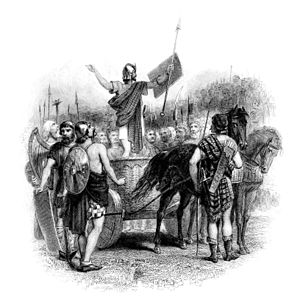Battle of Mons Graupius
The battle of Mons Graupius took place in the year 83 or 84. Gnaeus Iulius Agricola , the Roman governor of Britain , had sent his fleet to terrify the Caledonians and had marched north with light infantry , supported by British auxiliaries.
Although the Romans were outnumbered in their campaign against the British tribes, they found it difficult to bring their opponents to open battle. The Caledonians were the last to be subjugated, having avoided combat for many years. But now the Romans managed to force the battle by attacking the Caledonians' granaries just as they were full of harvest: the Caledonians had no choice, they had to fight to avoid starving the next winter.
The Caledonian hordes were not an equal opponent to the disciplined Roman legions . It is estimated that 20,000 Romans faced 30,000 Caledonian warriors, plus the usual gathering of women and children.
The 8,000 or so allied infantrymen stood in the center of the battle line, 3,000 cavalrymen on the wings. The legionaries were in reserve in front of the protective wall of their camp. The Caledonian army under Calgacus stood on higher ground, their advance troops on the plain, the others set up in steps, up the slope in the shape of a horseshoe.
After a brief skirmish with projectiles, Agricola ordered the auxiliaries to advance against the enemy. The Caledonians were pushed up the hill and attempted a pincer attack on the summit , but were themselves pinched by the Roman cavalry. The Caledonians were overwhelmed and fled to the nearby forest, where the well-organized Roman units ruthlessly pursued them.
It is said that the Roman legions did not intervene in the battle, had been in reserve all the time, and that the successful auxiliaries were Batavians . According to Tacitus (who was the son-in-law of the Roman commander) 10,000 Caledonians lost their lives against 360 deaths on the Roman side. It is likely, however, that Tacitus' description of the battle was a politically motivated exaggeration, either by Tacitus himself or by Agricola.
After this battle it was proclaimed that Agricola had finally subdued all of the British tribes. Shortly afterwards he was called back to Rome , so that his victories in the far north were not consistently exploited.
The battlefield could not be located, but would have to be in the Scottish highlands. Bennachie in Aberdeenshire on the border between the Highlands and the Lowlands has been suggested as the exact location. This is supported by a recently proposed etymology: If Graupius goes back to a Pictish word, related to Welsh crib (crest) - an element popular in the topography of all Celtic languages - it denotes a chain of hills with exactly the shape that can be observed in Bennachie .
A typing or reading error in the early modern period resulted in the form Grampius , which was fortified and led to the current name of the Grampian Mountains , later also the administrative district of the Grampian Region .
swell
- Tacitus : Agricola (De vita et moribus Iulii Agricolae), chap. 29-38
literature
- Christopher Haigh: The Cambridge Historical Encyclopedia of Great Britain and Ireland. Cambridge University Press, Cambridge 1990, ISBN 0-521-39552-6 , p. 27 ( restricted online version in the Google book search).
- Graham Ritchie , Anna Ritchie: Scotland. Archeology and early History. 2nd paperback edition. Edinburgh University Press, Edinburgh 1991, ISBN 0-7486-0291-7 , p. 126 ( restricted online version in Google book search).
- Nic Fields: Rome's Northern Frontier AD 70-235. Beyond Hadrian's Wall (= Fortress 31). Osprey Publishing, Oxford 2005, ISBN 1-8417-6832-4 , p. 8 ( restricted online version in the Google book search).
